GIS-Based Visitor Count Prediction and Environmental Susceptibility Zoning in Protected Areas: A Case Study in Plitvice Lakes National Park, Croatia
Abstract
:1. Introduction
2. Materials and Methods
2.1. Study Area
2.2. Acquiring and Analysis of Visitors Data
2.3. Short-Term Prediction of Future Visitors Data
2.4. Zoning of Environmental Susceptibility Affected by Visitors Count
3. Results
3.1. The Analysis of Visitors Count by Time Frames
3.2. Prediction and Evaluation of Short-Term Prediction of Future Visitors Data
3.3. Environmental Susceptibility Zones Weighted by Monthly Visitors Count
4. Discussion
5. Conclusions
Author Contributions
Funding
Institutional Review Board Statement
Informed Consent Statement
Data Availability Statement
Acknowledgments
Conflicts of Interest
References
- Travel & Tourism Economic Impact|World Travel & Tourism Council (WTTC). Available online: https://wttc.org/research/economic-impact (accessed on 13 December 2022).
- Nature Positive Travel and Tourism. Available online: https://research.wttc.org/nature-positive-travel-and-tourism (accessed on 13 December 2022).
- Croatian Bureau of Statistics Tourism in 2021. Available online: https://podaci.dzs.hr/media/gwcghawn/si-1700_turizam-u-2021.pdf (accessed on 13 December 2022).
- Protected Areas. Available online: https://mingor.gov.hr/o-ministarstvu-1065/djelokrug/uprava-za-zastitu-prirode-1180/zasticena-podrucja/1188 (accessed on 13 December 2022).
- Dudley, N. Guidelines for Applying Protected Area Management Categories; IUCN: Gland, Switzerland, 2008; ISBN 978-2-8317-1086-0. [Google Scholar]
- Law on the Protection of Nature. Available online: https://narodne-novine.nn.hr/clanci/sluzbeni/2013_06_80_1658.html (accessed on 13 December 2022).
- Esfehani, M.H.; Albrecht, J.N. Roles of Intangible Cultural Heritage in Tourism in Natural Protected Areas. J. Herit. Tour. 2018, 13, 15–29. [Google Scholar] [CrossRef]
- Rastegar, R. Tourism Development and Conservation, Do Local Resident Attitudes Matter? Int. J. Tour. Sci. 2019, 19, 181–191. [Google Scholar] [CrossRef]
- Marin-Pantelescu, A. Comparative Analysis between Romania, Bulgaria and Hungary’s Tourism Activity. Acad. J. Econ. Stud. 2018, 4, 176–182. [Google Scholar]
- Birendra, K.C. Complexity in Balancing Conservation and Tourism in Protected Areas: Contemporary Issues and Beyond. Tour. Hosp. Res. 2022, 22, 241–246. [Google Scholar] [CrossRef]
- Tajpour, M.; Hosseini, E.; Mohammadi, M.; Bahman-Zangi, B. The Effect of Knowledge Management on the Sustainability of Technology-Driven Businesses in Emerging Markets: The Mediating Role of Social Media. Sustainability 2022, 14, 8602. [Google Scholar] [CrossRef]
- Grigorescu, A.; Frinculeasa, M.-N.; Chitescu, R.-I. The Socio-Economic Value of Protected Areas. The Bucegi Natural Park. Manag. Dyn. Knowl. Econ. 2020, 8, 61–79. [Google Scholar]
- Daily, G.C.; Ellison, K. The New Economy of Nature: The Quest to Make Conservation Profitable; Island Press: Washington, DC, USA, 2002; ISBN 1-55963-945-8. [Google Scholar]
- Cessford, G.; Muhar, A. Monitoring Options for Visitor Numbers in National Parks and Natural Areas. J. Nat. Conserv. 2003, 11, 240–250. [Google Scholar] [CrossRef]
- Hadwen, W.L.; Hill, W.; Pickering, C.M. Icons under Threat: Why Monitoring Visitors and Their Ecological Impacts in Protected Areas Matters. Ecol. Manag. Restor. 2007, 8, 177–181. [Google Scholar] [CrossRef]
- Pickering, C.; Rossi, S.D.; Hernando, A.; Barros, A. Current Knowledge and Future Research Directions for the Monitoring and Management of Visitors in Recreational and Protected Areas. J. Outdoor Recreat. Tour. 2018, 21, 10–18. [Google Scholar] [CrossRef]
- Bielański, M.; Taczanowska, K.; Muhar, A.; Adamski, P.; González, L.-M.; Witkowski, Z. Application of GPS Tracking for Monitoring Spatially Unconstrained Outdoor Recreational Activities in Protected Areas—A Case Study of Ski Touring in the Tatra National Park, Poland. Appl. Geogr. 2018, 96, 51–65. [Google Scholar] [CrossRef]
- Buckley, R. Ecological Indicators of Tourist Impacts in Parks. J. Ecotourism 2003, 2, 54–66. [Google Scholar] [CrossRef] [Green Version]
- Hennig, S.; Künzl, M. Einblicke in Das Monitoring Zur Erholungsnutzung Im Nationalpark Berchtesgaden. Besuch. Okon. Eff. Natl. Nat. 2007, 1, 50–59. [Google Scholar]
- Levin, N.; Lechner, A.M.; Brown, G. An Evaluation of Crowdsourced Information for Assessing the Visitation and Perceived Importance of Protected Areas. Appl. Geogr. 2017, 79, 115–126. [Google Scholar] [CrossRef]
- Heikinheimo, V.; Minin, E.D.; Tenkanen, H.; Hausmann, A.; Erkkonen, J.; Toivonen, T. User-Generated Geographic Information for Visitor Monitoring in a National Park: A Comparison of Social Media Data and Visitor Survey. ISPRS Int. J. Geo-Inf. 2017, 6, 85. [Google Scholar] [CrossRef] [Green Version]
- Korpilo, S.; Virtanen, T.; Lehvävirta, S. Smartphone GPS Tracking—Inexpensive and Efficient Data Collection on Recreational Movement. Landsc. Urban Plan. 2017, 157, 608–617. [Google Scholar] [CrossRef] [Green Version]
- Wood, S.A.; Guerry, A.D.; Silver, J.M.; Lacayo, M. Using Social Media to Quantify Nature-Based Tourism and Recreation. Sci. Rep. 2013, 3, 2976. [Google Scholar] [CrossRef] [Green Version]
- Levin, N.; Kark, S.; Crandall, D. Where Have All the People Gone? Enhancing Global Conservation Using Night Lights and Social Media. Ecol. Appl. 2015, 25, 2153–2167. [Google Scholar] [CrossRef] [Green Version]
- Richards, D.R.; Friess, D.A. A Rapid Indicator of Cultural Ecosystem Service Usage at a Fine Spatial Scale: Content Analysis of Social Media Photographs. Ecol. Indic. 2015, 53, 187–195. [Google Scholar] [CrossRef]
- Sessions, C.; Wood, S.A.; Rabotyagov, S.; Fisher, D.M. Measuring Recreational Visitation at U.S. National Parks with Crowd-Sourced Photographs. J. Environ. Manage. 2016, 183, 703–711. [Google Scholar] [CrossRef]
- Walden-Schreiner, C.; Rossi, S.D.; Barros, A.; Pickering, C.; Leung, Y.-F. Using Crowd-Sourced Photos to Assess Seasonal Patterns of Visitor Use in Mountain-Protected Areas. Ambio 2018, 47, 781–793. [Google Scholar] [CrossRef]
- Horst, L.; Taczanowska, K.; Porst, F.; Arnberger, A. Evaluation of GNSS-Based Volunteered Geographic Information for Assessing Visitor Spatial Distribution within Protected Areas: A Case Study of the Bavarian Forest National Park, Germany. Appl. Geogr. 2023, 150, 102825. [Google Scholar] [CrossRef]
- Nematollahi, S.; Afghari, S.; Kienast, F.; Fakheran, S. Spatial Prioritization for Ecotourism through Applying the Landscape Resilience Model. Land 2022, 11, 1682. [Google Scholar] [CrossRef]
- Li, Y.; Yang, L.; Shen, H.; Wu, Z. Modeling Intra-Destination Travel Behavior of Tourists through Spatio-Temporal Analysis. J. Destin. Mark. Manag. 2019, 11, 260–269. [Google Scholar] [CrossRef]
- Guan, C.; Song, J.; Keith, M.; Zhang, B.; Akiyama, Y.; Da, L.; Shibasaki, R.; Sato, T. Seasonal Variations of Park Visitor Volume and Park Service Area in Tokyo: A Mixed-Method Approach Combining Big Data and Field Observations. Urban For. Urban Green. 2021, 58, 126973. [Google Scholar] [CrossRef]
- Sergiacomi, C.; Vuletić, D.; Paletto, A.; Fagarazzi, C. Exploring Tourist Preferences on the Visitor Management System: The Case Study of Plitvice Lakes National Park. South-East Eur. For. 2022, 13, 67–77. [Google Scholar] [CrossRef]
- Kovačević, T. (Ed.) Plitvice Lakes National Park Management Plan 2019–2028; Plitvice Lakes National Park Public Institution: Plitvička Jezera, Croatia, 2019. [Google Scholar]
- Ministry of Economy and Sustainable Development of the Republic of Croatia. Guidelines for Planning the Management of Protected Areas and/or Ecological Network Areas. Available online: https://www.haop.hr/hr/tematska-podrucja/zasticena-podrucja/upravljanje-zasticenim-podrucjima/smjernice (accessed on 14 December 2022).
- Ballantyne, M.; Pickering, C.M. The Impacts of Trail Infrastructure on Vegetation and Soils: Current Literature and Future Directions. J. Environ. Manage. 2015, 164, 53–64. [Google Scholar] [CrossRef] [Green Version]
- Barros, A.; Marina Pickering, C. How Networks of Informal Trails Cause Landscape Level Damage to Vegetation. Environ. Manage. 2017, 60, 57–68. [Google Scholar] [CrossRef]
- Pickering, C.M.; Growcock, A.J. Impacts of Experimental Trampling on Tall Alpine Herbfields and Subalpine Grasslands in the Australian Alps. J. Environ. Manage. 2009, 91, 532–540. [Google Scholar] [CrossRef]
- Barros, A.; Gonnet, J.; Pickering, C. Impacts of Informal Trails on Vegetation and Soils in the Highest Protected Area in the Southern Hemisphere. J. Environ. Manage. 2013, 127, 50–60. [Google Scholar] [CrossRef]
- Kim, Y.; Kim, C.; Lee, D.K.; Lee, H.; Andrada, R.I.T. Quantifying Nature-Based Tourism in Protected Areas in Developing Countries by Using Social Big Data. Tour. Manag. 2019, 72, 249–256. [Google Scholar] [CrossRef]
- Alegre, J.; Mateo, S.; Pou, L. A Latent Class Approach to Tourists’ Length of Stay. Tour. Manag. 2011, 32, 555–563. [Google Scholar] [CrossRef]
- Peter Wathern Environmental Impact Assessment: Theory and Practice. Available online: https://www.routledge.com/Environmental-Impact-Assessment-Theory-and-Practice/Wathern/p/book/9780415078849 (accessed on 14 December 2022).
- Kim, J.; Thapa, B.; Jang, S.; Yang, E. Seasonal Spatial Activity Patterns of Visitors with a Mobile Exercise Application at Seoraksan National Park, South Korea. Sustainability 2018, 10, 2263. [Google Scholar] [CrossRef] [Green Version]
- Reif, U. Constantly Adapting—Approaches for Effective Visitor Monitoring and Adaptive Visitor Guiding in the Black Forest National Park; Routledge: London, UK, 2019; pp. 93–103. ISBN 978-0-429-19798-7. [Google Scholar]
- Leung, Y.-F.; Spenceley, A.; Hvenegaard, G.; Buckley, R. (Eds.) Tourism and Visitor Management in Protected Areas: Guidelines for Sustainability, 1st ed.; IUCN, International Union for Conservation of Nature: Gland, Switzerland, 2018; ISBN 978-2-8317-1898-9. [Google Scholar]
- RAPPAM: Rapid Assessment and Prioritisation of Protected Area Management Tool. Available online: https://www.conservationgateway.org/ExternalLinks/Pages/rappam-rapid-assessment-a.aspx (accessed on 12 December 2022).
- Pietilä, M.; Fagerholm, N. A Management Perspective to Using Public Participation GIS in Planning for Visitor Use in National Parks. J. Environ. Plan. Manag. 2019, 62, 1133–1148. [Google Scholar] [CrossRef]
- Geneletti, D.; van Duren, I. Protected Area Zoning for Conservation and Use: A Combination of Spatial Multicriteria and Multiobjective Evaluation. Landsc. Urban Plan. 2008, 85, 97–110. [Google Scholar] [CrossRef]
- Phua, M.-H.; Minowa, M. A GIS-Based Multi-Criteria Decision Making Approach to Forest Conservation Planning at a Landscape Scale: A Case Study in the Kinabalu Area, Sabah, Malaysia. Landsc. Urban Plan. 2005, 71, 207–222. [Google Scholar] [CrossRef]
- Zhang, Z.; Sherman, R.; Yang, Z.; Wu, R.; Wang, W.; Yin, M.; Yang, G.; Ou, X. Integrating a Participatory Process with a GIS-Based Multi-Criteria Decision Analysis for Protected Area Zoning in China. J. Nat. Conserv. 2013, 21, 225–240. [Google Scholar] [CrossRef]
- Korpilo, S.; Virtanen, T.; Saukkonen, T.; Lehvävirta, S. More than A to B: Understanding and Managing Visitor Spatial Behaviour in Urban Forests Using Public Participation GIS. J. Environ. Manage. 2018, 207, 124–133. [Google Scholar] [CrossRef] [Green Version]
- Brown, G.; Weber, D. Public Participation GIS: A New Method for National Park Planning. Landsc. Urban Plan. 2011, 102, 1–15. [Google Scholar] [CrossRef]
- Schägner, J.P.; Brander, L.; Maes, J.; Paracchini, M.L.; Hartje, V. Mapping Recreational Visits and Values of European National Parks by Combining Statistical Modelling and Unit Value Transfer. J. Nat. Conserv. 2016, 31, 71–84. [Google Scholar] [CrossRef]
- Abang Abdurahman, A.Z.; Wan Yaacob, W.F.; Md Nasir, S.A.; Jaya, S.; Mokhtar, S. Using Machine Learning to Predict Visitors to Totally Protected Areas in Sarawak, Malaysia. Sustainability 2022, 14, 2735. [Google Scholar] [CrossRef]
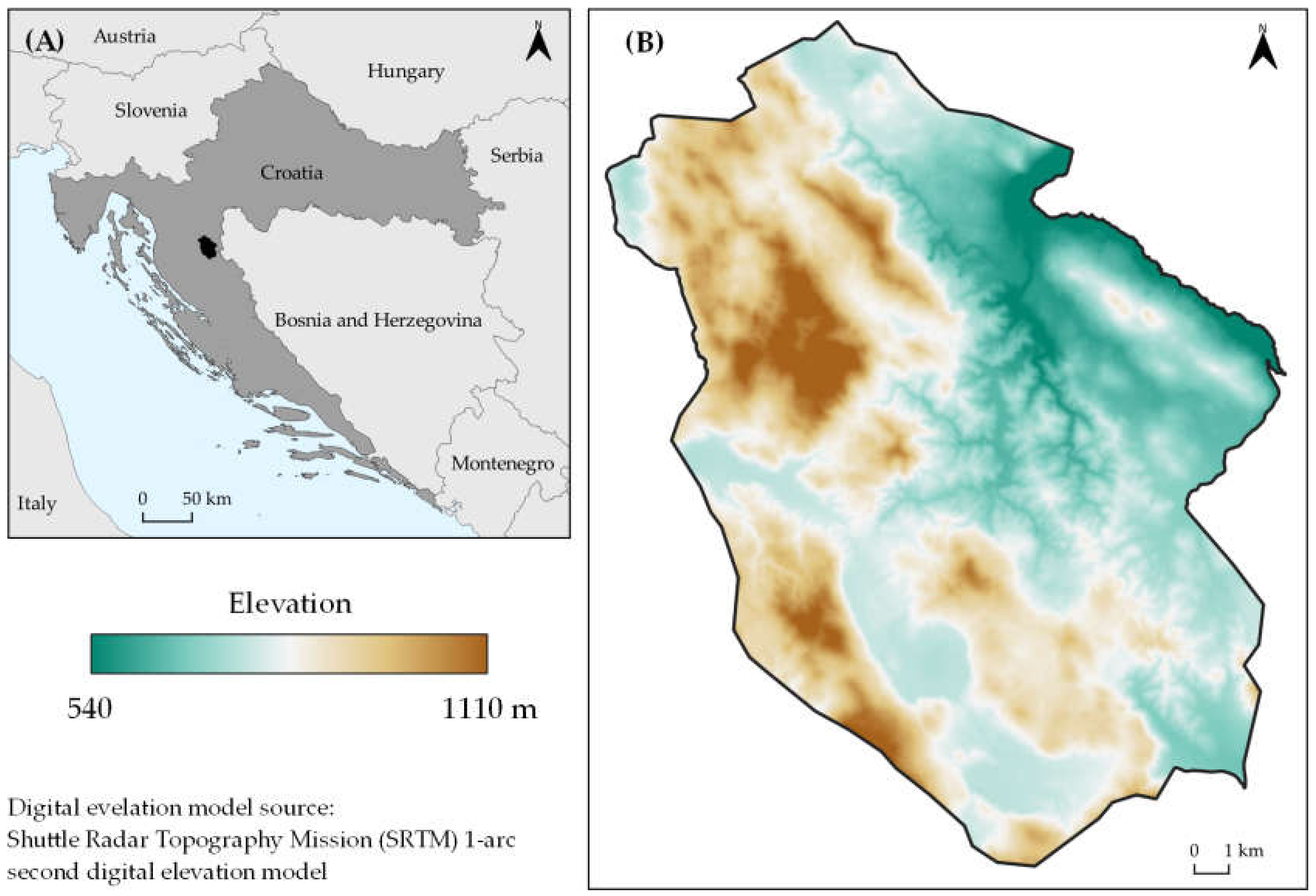
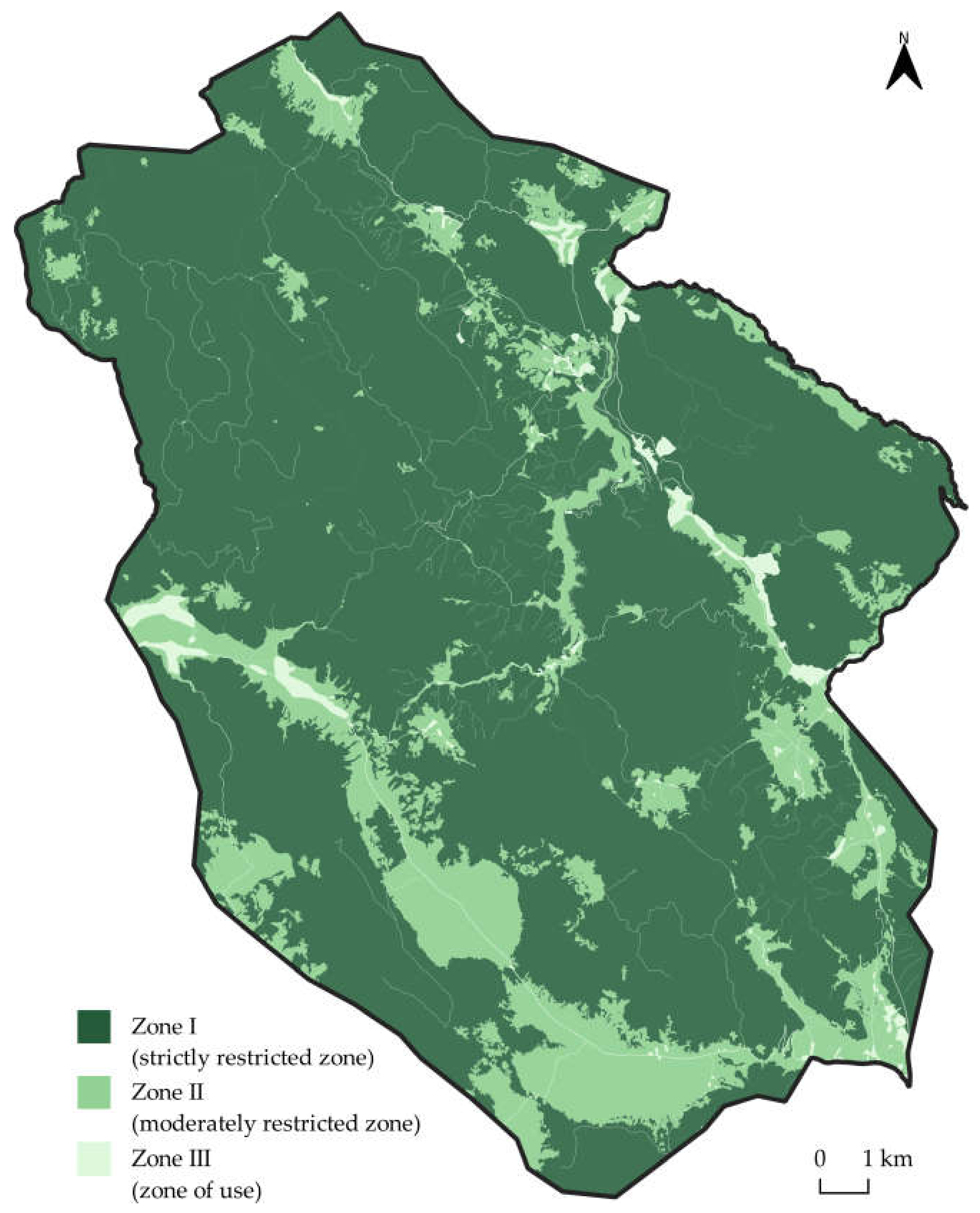

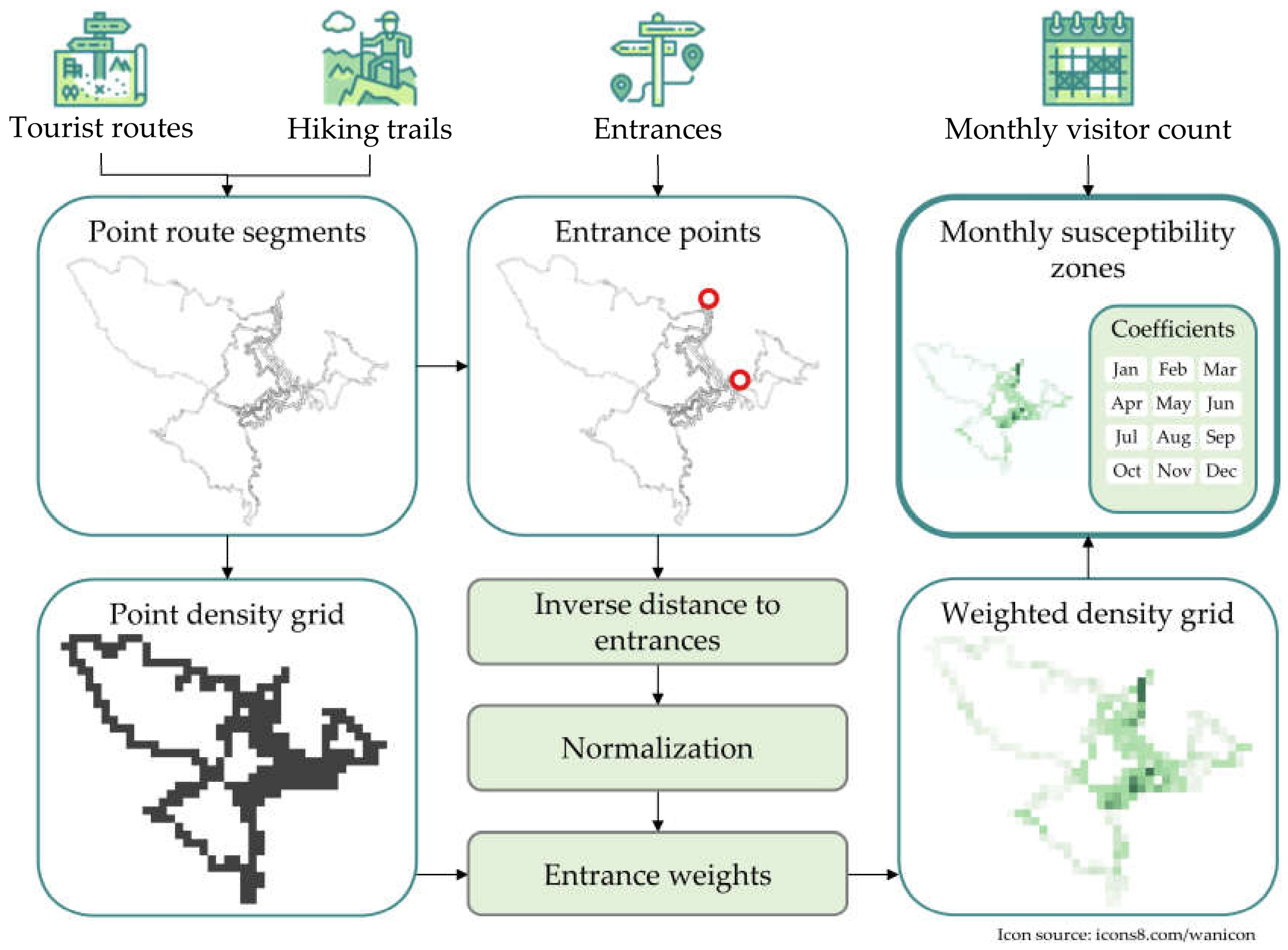
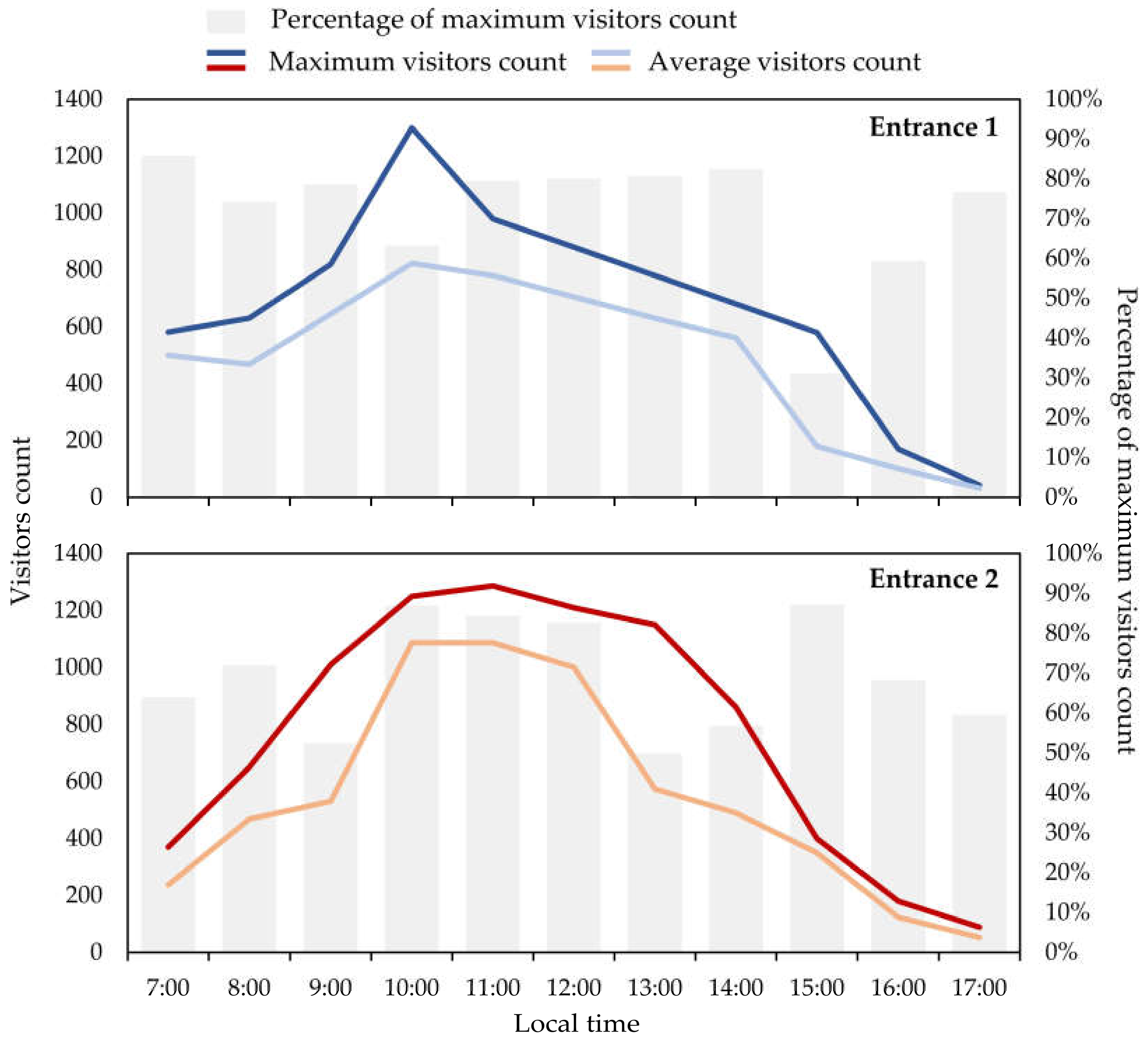
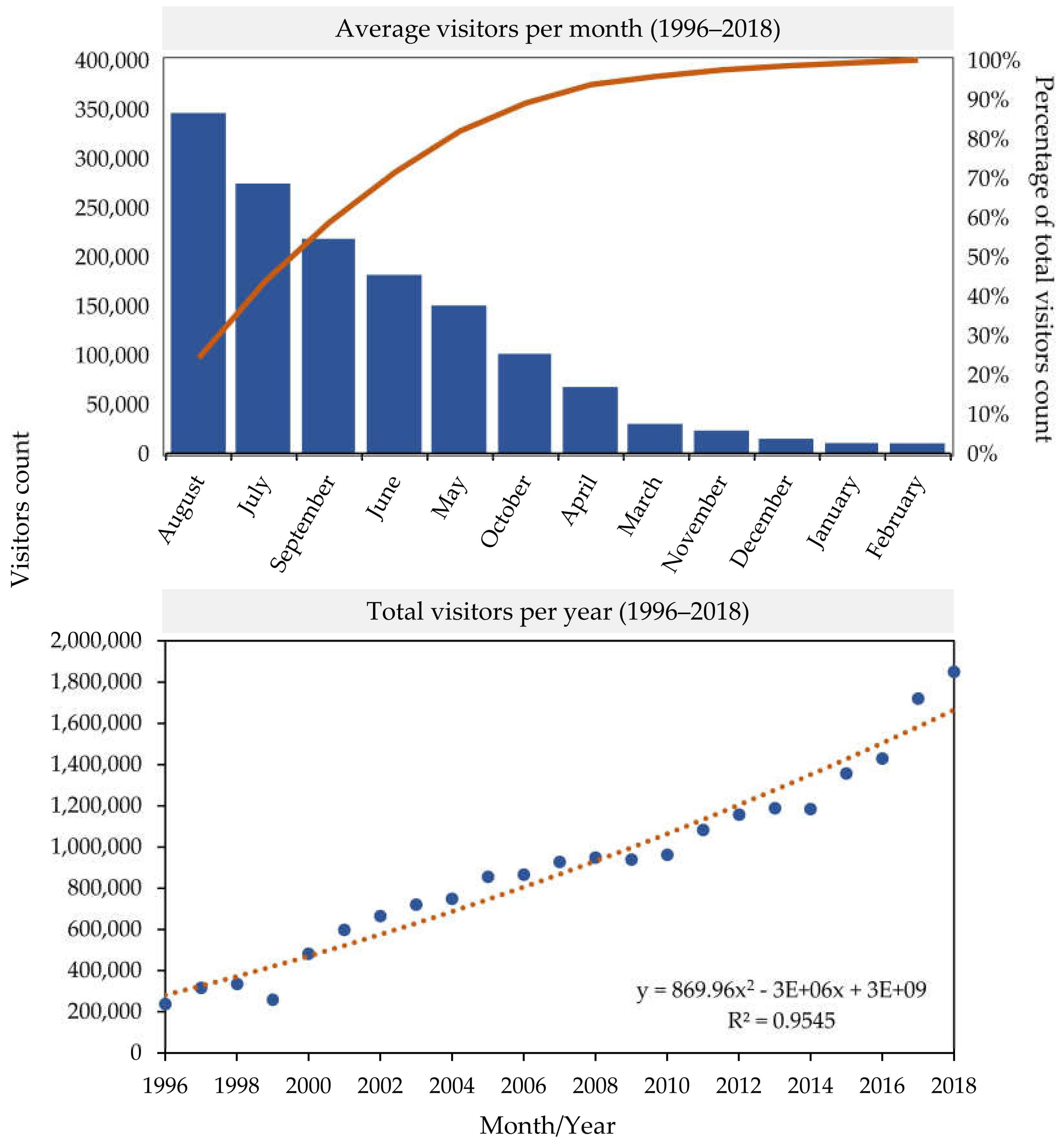
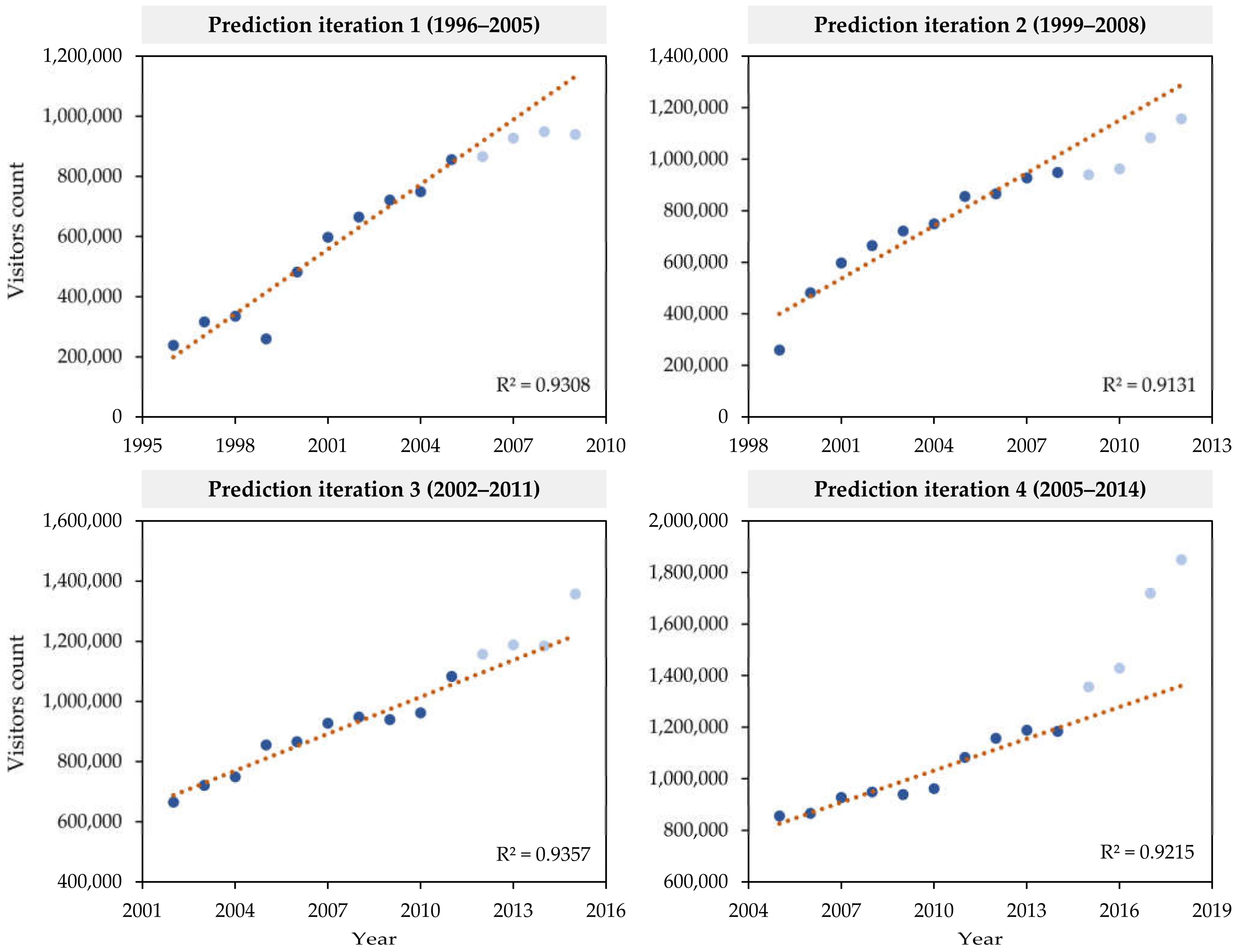

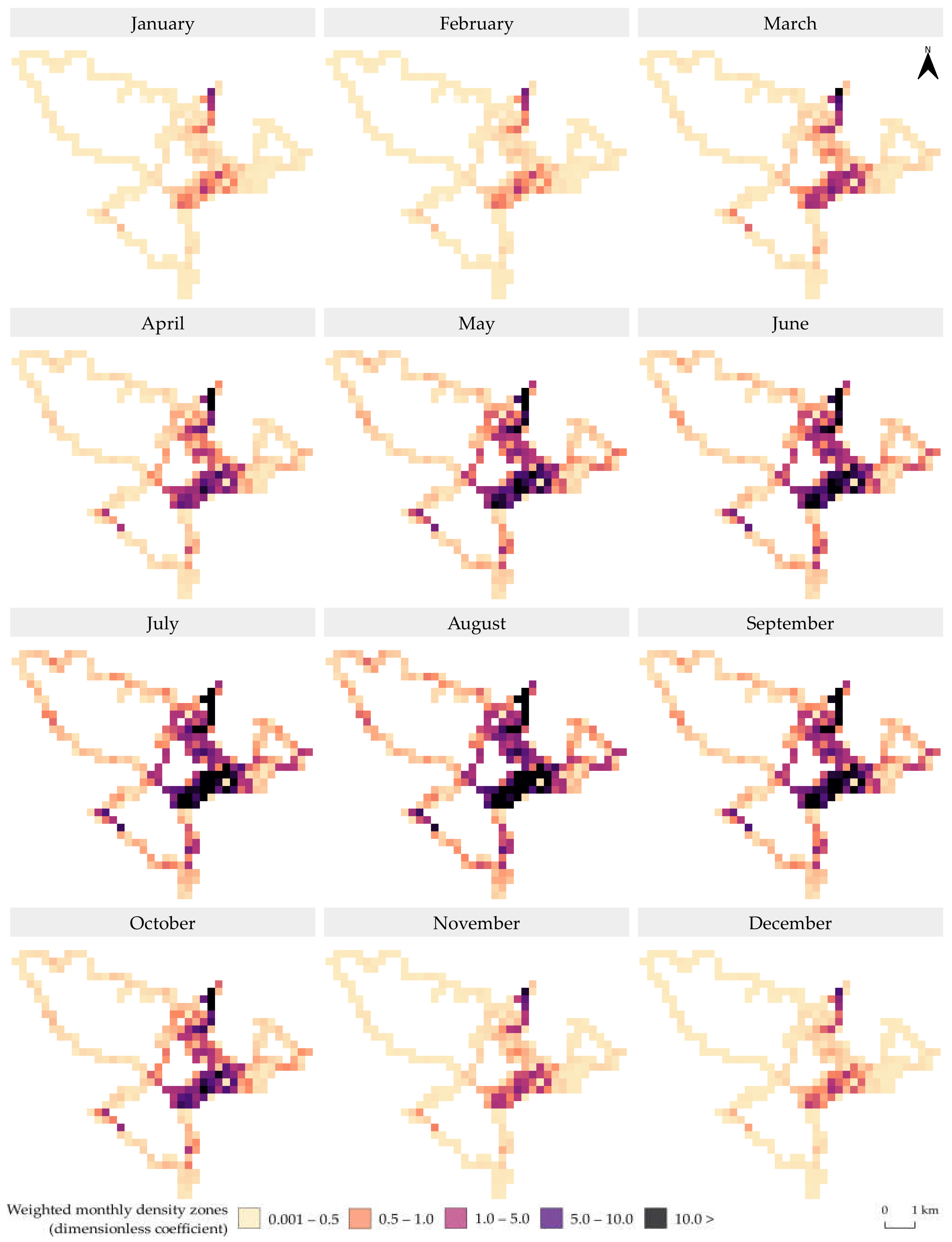
| Management Zone | Management Subzone | Area (ha) | Total Area Percentage (%) | |
|---|---|---|---|---|
| Abbreviation | Description | |||
| Zone I (strictly restricted zone) | IA | No visits | 3986.9 | 13.4 |
| IB | With limited attendance | 19,934.8 | 67.3 | |
| Zone II (moderately restricted zone) | IIA | Water ecosystems | 278.3 | 0.9 |
| IIB | Lawns and sedges | 4384.5 | 14.8 | |
| IIC | Cultural landscape | 405.0 | 1.4 | |
| Zone III (zone of use) | IIIA | Settlement areas | 375.6 | 1.3 |
| IIIB | Traffic roads | 115.3 | 0.4 | |
| IIIC | Built-up areas with visitor services | 79.3 | 0.3 | |
| IIID | Tracks, roads and docks | 71.1 | 0.2 | |
| Iteration Number | Training Data Interval | Prediction Interval | R2 | RMSE | NRMSE | MAE |
|---|---|---|---|---|---|---|
| Iteration 1 | 1996–2005 | 2006–2009 | 0.700 | 118,242 | 0.128 | 104,092 |
| Iteration 2 | 1999–2008 | 2009–2012 | 0.946 | 151,358 | 0.146 | 149,592 |
| Iteration 3 | 2002–2011 | 2012–2015 | 0.710 | 79,471 | 0.065 | 63,738 |
| Iteration 4 | 2005–2014 | 2015–2018 | 0.951 | 330,239 | 0.208 | 289,803 |
Disclaimer/Publisher’s Note: The statements, opinions and data contained in all publications are solely those of the individual author(s) and contributor(s) and not of MDPI and/or the editor(s). MDPI and/or the editor(s) disclaim responsibility for any injury to people or property resulting from any ideas, methods, instructions or products referred to in the content. |
© 2023 by the authors. Licensee MDPI, Basel, Switzerland. This article is an open access article distributed under the terms and conditions of the Creative Commons Attribution (CC BY) license (https://creativecommons.org/licenses/by/4.0/).
Share and Cite
Jurišić, M.; Plaščak, I.; Rendulić, Ž.; Radočaj, D. GIS-Based Visitor Count Prediction and Environmental Susceptibility Zoning in Protected Areas: A Case Study in Plitvice Lakes National Park, Croatia. Sustainability 2023, 15, 1625. https://doi.org/10.3390/su15021625
Jurišić M, Plaščak I, Rendulić Ž, Radočaj D. GIS-Based Visitor Count Prediction and Environmental Susceptibility Zoning in Protected Areas: A Case Study in Plitvice Lakes National Park, Croatia. Sustainability. 2023; 15(2):1625. https://doi.org/10.3390/su15021625
Chicago/Turabian StyleJurišić, Mladen, Ivan Plaščak, Željko Rendulić, and Dorijan Radočaj. 2023. "GIS-Based Visitor Count Prediction and Environmental Susceptibility Zoning in Protected Areas: A Case Study in Plitvice Lakes National Park, Croatia" Sustainability 15, no. 2: 1625. https://doi.org/10.3390/su15021625
APA StyleJurišić, M., Plaščak, I., Rendulić, Ž., & Radočaj, D. (2023). GIS-Based Visitor Count Prediction and Environmental Susceptibility Zoning in Protected Areas: A Case Study in Plitvice Lakes National Park, Croatia. Sustainability, 15(2), 1625. https://doi.org/10.3390/su15021625









